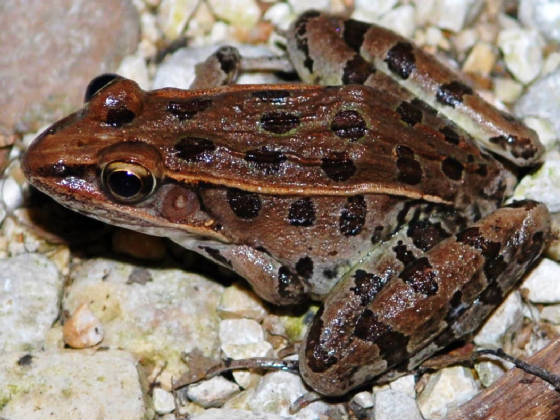|
|
We all know that birds sing beautiful songs, but many other animals
also sing. If you are out at night, you may hear frogs singing. Unlike birds, frogs are cold blooded and their songs speed
up and slow down depending on the temperature. Southern Leopard Frogs are common in Texas and sing from their homes in swamps throughout the winter.
Here are six recordings of Southern Leopard Frogs at Creekfield Lake in Brazos Bend State Park (near Houston, Texas). Can you order the recordings by how warm the frogs were? Each recording lists the air temperature
at the time. Is the frog's temperature the same as the air temperature?
What other sounds can you hear in these recordings?
At Brazos Bend State Park the leopard frogs sing all winter long (except in the daytime and when it gets near or below freezing). Chorus frogs are also active in the winter, but only after a heavy rain, and may only sing a few nights a year. Here is a recording made in the evening after a day of heavy rain. The leopard frogs also become more active after rain! Chorus and Leopard frogs (51F) The leopard frogs also sing into the spring, but once the
weather gets warmer they get a lot of competition and become much less noticeable. Here is a recording from May. Can you hear
the leopard frogs in the mix? The frogs that sound a bit like a quacking duck are squirrel tree frogs. The frogs that sound like castanets are cricket frogs. The single frog that comes in very loudly towards the end of the recording is a green tree frog (you can also hear more distant ones throughout the entire recording, making a sort of syncopated back beat track).
And there are still more species of frogs in Brazos Bend State Park than these! How do they tell each other apart in that mess? Each species is best at hearing its own call. That's true for people, too! When I listen to this recording I sometimes think I can just hear someone quietly talking in the background, spoiling the recording. I can't ever quite seem to understand what they are saying, though! When I turn up the volume and listen very carefully, however, I realize I'm hearing the low grumbling calls of the leopard frogs, which can sound a bit like someone talking if you can't hear them well. There are no human voices in this recording! All audio recordings on this page copyright (c) Joe Dellinger, 2007-2011.
|
